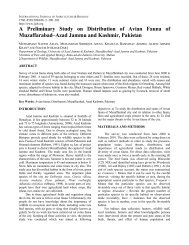Notes on Typhlops diardi - the Wildlife of Pakistan Website
Notes on Typhlops diardi - the Wildlife of Pakistan Website
Notes on Typhlops diardi - the Wildlife of Pakistan Website
You also want an ePaper? Increase the reach of your titles
YUMPU automatically turns print PDFs into web optimized ePapers that Google loves.
4<br />
Paratypes: (five specimens) , MSK 0930.94 and MSK<br />
0933.94, adult males, under vegetati<strong>on</strong> debris, 24 July,<br />
1994; MSK 0605.96, adult male, exposed during digging a<br />
water channel, 14 August, 1996; MSK 0901.93, adult<br />
female, under logs, 26 June, 1993; MSK 0932.94, adult<br />
female, roots <strong>of</strong> a pine tree, 4 September, 1994. Rest<br />
data as for holotype.<br />
Diagnosis: A stout-bodied <strong>Typhlops</strong>, with distinctly<br />
flat ventrum; 22-25 scales round <strong>the</strong> midbody; head flat,<br />
wider than body, tail at vent wider than l<strong>on</strong>g; eyes<br />
large with a distinct pupil; nasal cleft incomplete; a<br />
large subnarial glandular pit, nasal cleft in c<strong>on</strong>tact<br />
with sec<strong>on</strong>d supralabial; head squamous glands c<strong>on</strong>fined<br />
to sutures, descend in parallel diagnal rows <strong>on</strong>to <strong>the</strong><br />
supralabials; <strong>the</strong> posterior nasal overlaps first and<br />
sec<strong>on</strong>d supralabials, third supralabial overlapped by<br />
preocular and overlaps ocular; ocular overlaps fourth<br />
supralabial; microtubercles are scattered <strong>on</strong> <strong>the</strong> surface<br />
<strong>of</strong> all head scales; dorsum light brown, ventrum dirty<br />
white; tail with sharp ventrad bent, tip round,<br />
with a str<strong>on</strong>g cuspidate spine.<br />
Descripti<strong>on</strong> <strong>of</strong> holotype (measurements in mm): CAS<br />
170526, Fig. 1, A. Adult male, total length 295, tail<br />
length 7.0+spine, midbody diameter : dorso-ventral<br />
(height) 4.15, lateral (width) 6.15; diameter at <strong>the</strong><br />
level <strong>of</strong> vent: dorso-ventral 5.75, lateral 7.15;<br />
middorsal scales 271, midventral 278, dorso-caudals<br />
10 + spine, subcaudals 11 + spine; scale rows round <strong>the</strong><br />
body: at neck 27, at midbody 25, at level <strong>of</strong> vent 22.<br />
When viewed from above, snout broadly rounded, head<br />
gradually broadens, broadest at a point bey<strong>on</strong>d oculars,<br />
slight taper at neck. In lateral pr<strong>of</strong>ile, <strong>the</strong> snout<br />
extends over <strong>the</strong> mouth as much as <strong>the</strong> breadth <strong>of</strong><br />
rostral scale. Dorsum c<strong>on</strong>vex with 16 scales, ventrum<br />
distinctly flat, posterior part <strong>of</strong> body and tail<br />
sharply bent ventrad, tail tip round, ending in a<br />
cuspidate solid spine.<br />
Rostral scale keel-less, naris anterolateral,<br />
oblique crescent-like slits, lying in an oblique oval<br />
depressi<strong>on</strong>, <strong>the</strong> narial opening about half <strong>the</strong> size <strong>of</strong><br />
<strong>the</strong> eye, much nearer <strong>the</strong> tip <strong>of</strong> snout than eye; eyes<br />
dorso-lateral, not visible in ventral view, located in<br />
an orbital-pit excavated in <strong>the</strong> preocular scale, eye<br />
diameter 0.54 mm, pupil distinct. Rostral width 1.7<br />
mm, about <strong>on</strong>e third <strong>the</strong> head breadth, extends to <strong>the</strong><br />
level <strong>of</strong> eyes, tip broadly round. Nasal is <strong>the</strong> largest<br />
head scale, a weak nasal suture extends obliquely upward<br />
4




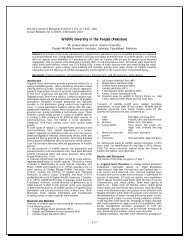
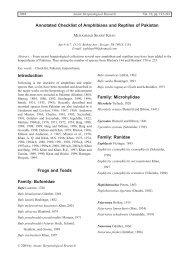



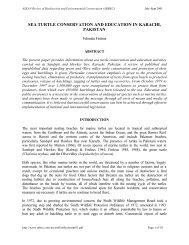
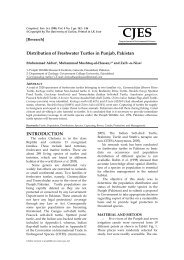
![Dureji (Ovis orientalis [vignei] blanfordi) - Wildlife of Pakistan](https://img.yumpu.com/11814520/1/190x245/dureji-ovis-orientalis-vignei-blanfordi-wildlife-of-pakistan.jpg?quality=85)
